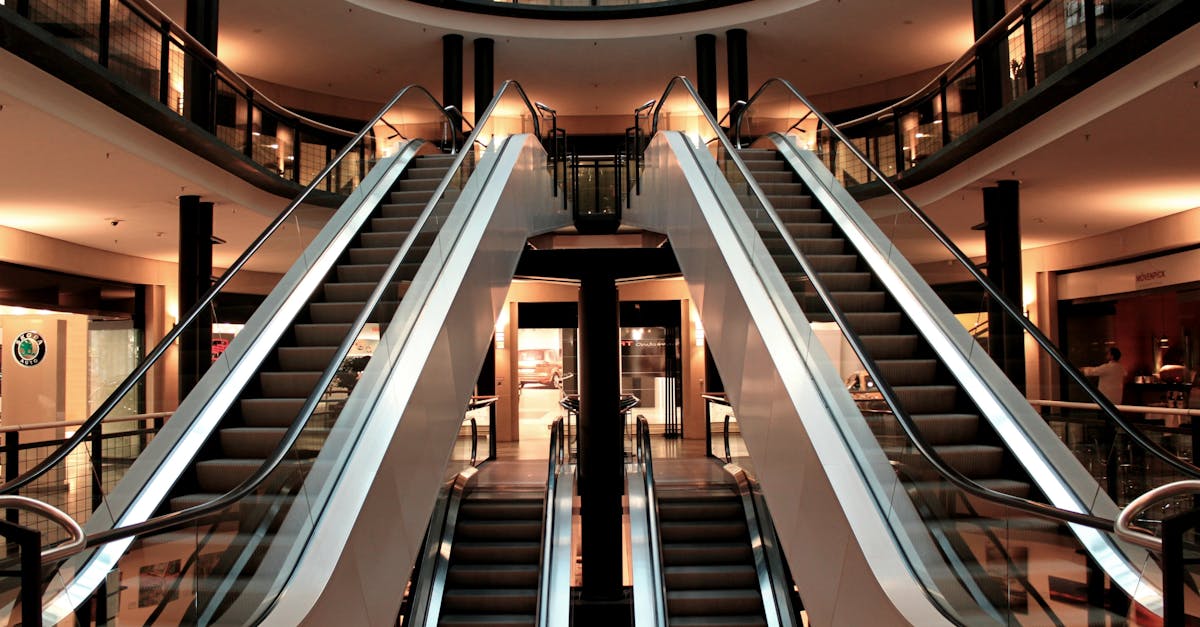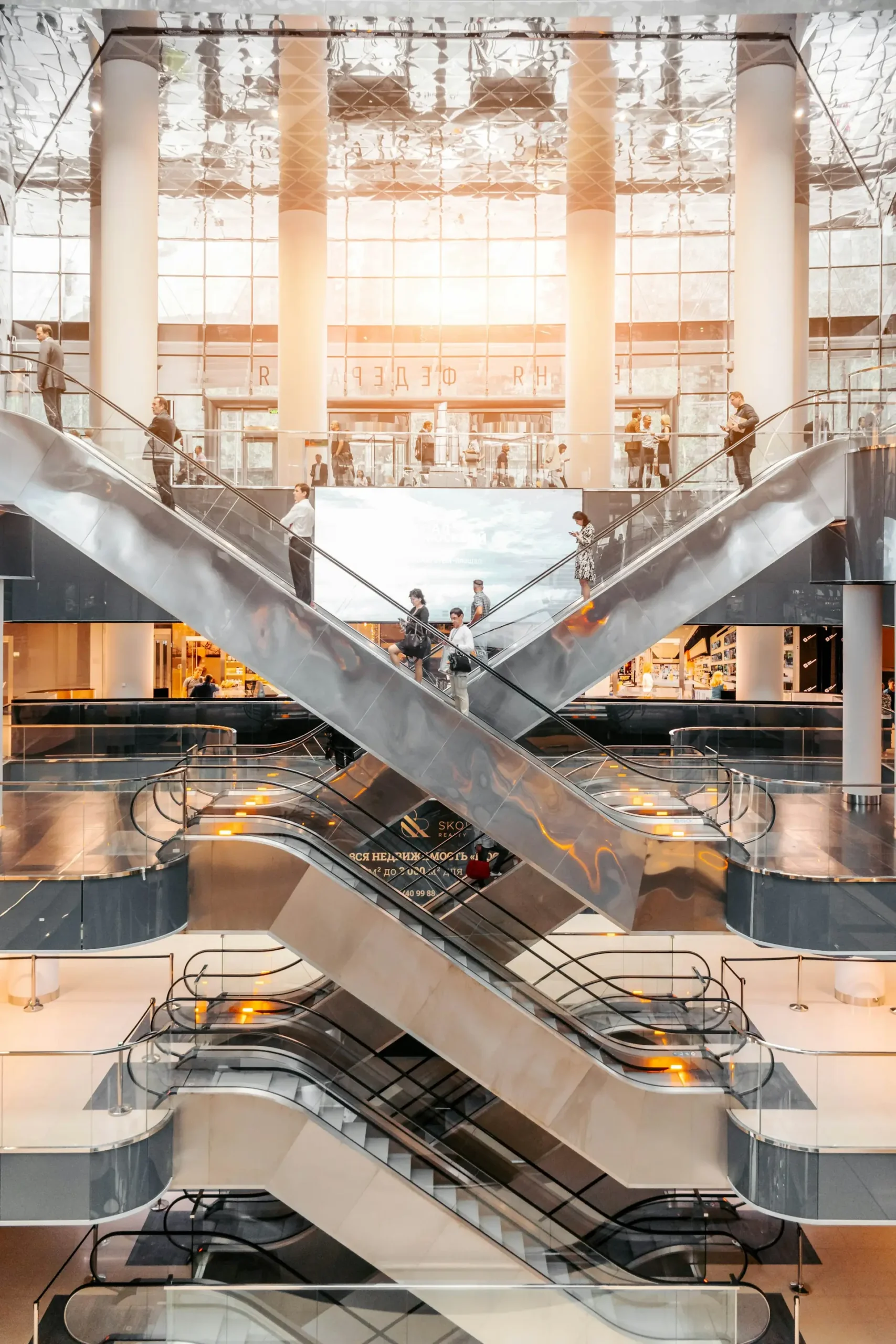Introducing Curvspace Escalators
Curvspace escalators represent a significant innovation in transportation. At Curvspace, we inspire you to transform the way you navigate multi-level spaces with our cutting-edge designs. These escalators navigate making them ideal for complex architectural spaces. Unlike traditional straight escalators models can turn corners, offering greater design flexibility and improving traffic flow. They seamlessly blend convenience with functionality, revolutionizing how we navigate spaces from bustling shopping malls to busy metro stations. Escalators are particularly beneficial in transitional spaces, providing smooth and efficient movement. Advanced mechanical systems and cutting-edge technology ensure durability and safety, while energy-efficient motors and regenerative braking contribute to sustainability efforts. These features make escalators a valuable addition to modern architecture, enhancing both aesthetics and functionality.
Reader Disclosure
Jump to:
What is an Escalator?
An escalator is a moving staircase that transports people between floors of a building. It’s a continuous moving belt-like system equipped with steps that move upward or downward on a track. Devised to handle substantial foot traffic, escalators operate using a series of motor-driven chains and pulleys, ensuring seamless transportation.
Modern escalators include features like sensors, emergency stop switches, and handrails synchronized with step movement. Advanced materials and design improvements enhance safety and efficiency.
In commercial spaces like malls, airports, and transit systems, escalators facilitate efficient crowd management by reducing bottlenecks. They offer an accessible option compared to elevators, especially for those who have minor mobility issues but can still navigate short flights of steps.
The History of Escalators
Escalators have fascinating origins dating back to the 19th century. The first patent for an “escalator” was granted to Jesse W. Reno in 1892 in New York. Reno’s design involved a moving inclined walkway with a continuous belt of steps, initially installed as an amusement ride at Coney Island in 1896.
Charles Seeberger improved Reno’s design in 1899 by creating the first electric, inclined moving stairway. He collaborated with the Otis Elevator Company, leading to the first commercial Escalator, debuted at the Paris Exposition in 1900. Seeberger’s innovations included steps with cleats and more robust safety mechanisms.
Escalator use expanded rapidly in the early 20th century. Department stores, subway stations, and public buildings adopted them to move people efficiently between floors. By 1921, the term “escalator” became a registered trademark of the Otis Elevator Company. However, it later became a generic term.
Technological advancements in the mid-20th century led to the development of more reliable, safer escalators. Variable speed control, improved handrail designs and advanced braking systems became standard. These enhancements ensured escalators could handle higher traffic volumes safely and comfortably.
Modern escalators now feature technologies unimaginable a century ago. Real-time monitoring systems, energy-efficient modes, and ergonomic designs make them an integral part of urban infrastructure. They continue to evolve, driven by advances in technology and design, meeting the ever-growing demands for safety, efficiency, and accessibility in public transport and commercial spaces.
Purpose of Escalators
Escalators enhance mobility, particularly in multi-level spaces. By providing continuous movement, they streamline flow in busy areas, thereby reducing congestion. Escalators make navigation easier in places like malls, airports, and subway stations. They’re especially beneficial in facilitating access for individuals with minor mobility issues.
In commercial spaces, escalators help optimize traffic management. They ease crowd movement effectively. Unlike elevators, escalators can handle a higher volume of people in shorter periods. This efficiency is crucial during peak hours.
Safety features in modern escalators include sensors, emergency stop switches, and handrails. These technologies boost user confidence and reduce accident risks. Regular maintenance ensures unimpeded, safe operation.
Space efficiency is another advantage. Escalators occupy less floor space compared to traditional stairways, allowing more room for commercial activities. Architects and urban planners favor escalators for their spatial economy.
Moreover, escalators contribute to energy conservation. Modern designs come with energy-efficient motors and systems that reduce power consumption during off-peak times. Sustainability is a growing focus in newer models, aligning with global environmental goals.
Ultimately, escalators facilitate smooth, continuous, and safe movement in various settings. Their integration into infrastructure supports both functional and architectural objectives.
Types of Escalators
Modern-day escalators cater to various needs and environments. Here are the main types:
Parallel Escalators
Parallel escalators have two or more escalators side-by-side, running in the same direction. They’re often found in busy locations like malls and train stations. These escalators efficiently handle large crowds by directing traffic flow in one continuous direction.
Crisscross Escalators
Crisscross escalators often stack in pairs and alternate directions. This setup is common in multi-floor buildings, allowing continuous movement between floors. Retail spaces and airports frequently use this type due to its space-saving design.
Spiral Escalators
Spiral escalators curve around a central axis, unlike traditional straight escalators. They offer an elegant solution for locations where space is limited but a visually appealing design is desired. You’ll see these in high-end commercial buildings or architectural projects with unique design requirements.
Curved Escalators
Curved escalators don’t form a complete spiral but bend slightly to conform to a building’s architecture. These escalators conserve space and enhance the aesthetic appeal of the environment. They’re suitable for settings where traditional straight-line escalators wouldn’t fit well.
Step-Type Escalators
Step-type escalators feature steps that level out horizontally as they move, providing a stable and safe ride. These are the most common type and dominate public transportation hubs, shopping centers, and commercial buildings.
Cleat-Type Escalators
Cleat-type escalators have slats instead of steps and generally use in industrial or special-purpose environments. This design allows for the transportation of larger, bulkier items that wouldn’t fit on traditional step-type escalators. Factories and warehouses often employ these escalators.
Outdoor Escalators
Outdoor escalators specifically design to withstand weather conditions like rain, snow, and extreme temperatures. These escalators feature durable materials and protective covers. Shopping centers, public transit systems, and open-air venues commonly use these.
Different types of escalators meet diverse functional and design requirements, making them versatile components in modern infrastructure.

Contemporary Uses of Escalators
Escalators play a crucial role in modern infrastructure. They’re commonly found in transportation hubs like airports, train stations, and metro systems, facilitating swift and efficient passenger movement. Shopping malls and retail stores use escalators to improve customer flow and enhance the shopping experience across multiple floors. Office buildings utilize escalators to ensure smooth vertical transportation for employees and visitors, supporting productivity.
Entertainment venues, such as theaters and stadiums, employ escalators to manage large crowds effectively, reducing wait times and preventing congestion. Hospitals and healthcare facilities integrate escalators to offer accessible movement for patients, visitors, and staff, aiding in overall facility efficiency. Museums and galleries incorporate escalators to provide seamless transitions between exhibits and floors, enhancing visitor experiences.
Modern architecture often features escalators as design elements, providing aesthetic value while serving functional purposes. Outdoor escalators appear in public spaces and urban environments where they improve accessibility and connectivity. In many cities, outdoor covered escalators facilitate transit in steep or uneven areas, contributing to urban mobility and ease of access.
Escalators in convention centers and exhibition halls handle high traffic volumes during events, ensuring quick and efficient visitor movement. Industrial facilities and warehouses use heavy-duty escalators for the transportation of goods and personnel, enhancing operational efficiency.
Modern Trends in Escalator Design
Modern escalator design incorporates technology and aesthetics to meet today’s demands. Energy efficiency is a primary trend, with features like automated start-stop functions and energy-efficient motors. These technologies reduce energy consumption especially during low-peak hours, enhancing sustainability.
Safety innovation is another trend. Enhanced handrails, multiple safety sensors, and obstruction detection systems are now standard. These features minimize accidents and improve overall user confidence.
Design aesthetics have also evolved. Customizable lighting, sleek materials, and minimalistic designs blend seamlessly into modern architecture. For example, LED lighting in handrails and steps adds both functionality and visual appeal.
Environmental adaptation is crucial. Outdoor escalators now use weather-resistant materials and anti-slip surfaces. These upgrades ensure reliability in diverse climates, from freezing temperatures to intense heat.
Smart technology integration revolutionizes user experience. IoT-enabled escalators provide real-time data monitoring, predictive maintenance alerts, and usage analytics. These advancements reduce downtime and optimize maintenance schedules.
Accessibility improvements are also notable. Lowered step heights and wider treads make escalators more inclusive for all users, including those with mobility challenges.
Sustainability, safety, aesthetics, environment-friendly materials, smart features, and accessibility drive modern escalator trends. This ensures escalators not only meet operational needs but also align with evolving architectural and societal standards.
Together, these trends make escalators more efficient, safer, and visually appealing, adapting seamlessly into modern infrastructure.
Cultural Diversity in Escalators Design
Escalator designs reflect cultural diversity across regions. Each region tailors escalator aesthetics and functionalities to its unique cultural context. Asian countries, for example, often incorporate vibrant colors and intricate patterns in escalator designs found in airports and shopping centers. This mirrors their traditional art forms and contemporary tastes, creating a visually appealing, culturally resonant experience.
European countries emphasize historic integration in escalator design. In cities with rich architectural heritage like Rome or Paris, designers use materials and styles that blend seamlessly with historic settings. Wooden handrails, wrought iron details, and subtle lighting ensure that escalators in these regions respect and complement the surrounding architecture.
North America prioritizes sleek, modern designs focusing on practicality and minimalism. Stainless steel finishes, efficient lighting, and simple lines dominate escalator installations in major urban centers like New York and Chicago. This approach reflects a broader cultural emphasis on progress, efficiency, and forward-thinking design philosophies.
In the Middle Eastern countries, escalator designs often incorporate luxurious materials. Gold detailing, marble steps, and ornate embellishments align with the region’s affinity for opulence and grandeur, visible in high-end malls and luxury hotels. These designs provide an upscale experience befitting the region’s socio-economic context.
Latin American countries blend vibrant cultural elements with modern needs. Escalators in places like Brazil and Mexico often feature colorful mosaics, murals, and motifs that celebrate local culture while ensuring robust, functional use in busy public spaces.
Diverse cultural approaches to escalator design showcase how infrastructure development aligns with societal values and traditions. These tailored designs enhance user experiences, reflecting the unique cultural identities of regions around the world.
Curvspace Qualities of Escalators
Curvspace escalators enhance architectural flexibility by fitting seamlessly into various building designs. At Curvspace, we inspire you to transform how you experience multi-level spaces with our innovative escalator design ideas. Their ability to navigate tight spaces without compromising capacity or safety makes them ideal for complex layouts in shopping malls or airports. Unlike straight escalators, curved models provide better spatial utilization and adaptability.
Escalators create a visually dynamic experience, allowing architects to integrate flowing lines, break monotony, and add a sense of movement. This visual appeal attracts more foot traffic in commercial spaces, enhancing overall engagement.
Customization options in escalators address diverse needs. They adapt to different incline angles, rise heights, and design aesthetics. With custom handrails, lighting, and finishes available, these escalators can match the surrounding architecture, ensuring aesthetic harmony.
Advanced safety features in curved escalators are integral to user protection. Integrated sensors, automatic lubrication systems, and emergency stop buttons enhance reliability and safety, providing peace of mind.
Efficiency is a key aspect of curved escalators, meeting energy-saving norms. Their design minimizes power consumption and contributes to overall sustainability goals. Energy-efficient motors and systems help reduce operational costs.
Modern technology further boosts the user experience in curved escalators. Features like smart monitoring systems, predictive maintenance, and real-time usage data improve performance and reliability, ensuring a smoother ride with fewer interruptions.
Considering these qualities, Curvspace escalators are versatile, attracting users while maintaining safety and efficiency. They elevate architectural aesthetics and functionality in public and commercial spaces.
People Also Ask
What are the primary benefits of modern escalators?
Modern escalators enhance mobility, improve safety, and conserve energy. They provide efficient transportation in crowded settings like malls and transportation hubs, incorporating features like motion sensors and energy-saving modes.
How do escalator types differ based on usage?
Escalators vary by design and function to meet specific needs. For instance, heavy-duty escalators are used in transit systems, while lighter versions are suited for shopping malls or commercial buildings.
What are the latest trends in escalator design?
Current trends focus on energy efficiency, aesthetic appeal, advanced safety features, technology integration, and accessibility improvements. Designers incorporate materials and technologies that align with these aspects.
How do escalator designs reflect cultural differences globally?
Escalator designs vary significantly around the world: Asia uses vibrant colors, Europe blends with historic architecture, North America prefers sleek modernity, the Middle East uses luxurious materials, and Latin America combines cultural elements with functionality.
What makes escalators unique?
Escalators offer architectural flexibility, improve spatial utilization, and have high visual appeal. They can be customized for specific spaces and incorporate advanced safety features and modern technologies.
Why are escalators important in transportation hubs?
Escalators manage high foot traffic efficiently, ensuring smooth movement and reducing congestion. Their design also includes robust construction and safety elements suitable for public spaces with heavy usage.
How do modern escalators ensure user safety?
Modern escalators employ advanced safety features such as motion sensors, emergency stop buttons, and regular maintenance checks. These elements help prevent accidents and ensure safe operation for users.
What role does technology play in escalator advancement?
Technology enhances escalator efficiency and safety, integrating features like automated stop-start functions, real-time monitoring systems, and energy-efficient components. This results in lower operational costs and improved user experience.
Are there energy-efficient escalators available?
Yes, energy-efficient escalators are now common, using innovations like regenerative drives, LED lighting, and motion sensors to reduce energy consumption and operational costs while maintaining high performance.
Conclusion
Escalators have come a long way from their humble beginnings, evolving into essential components of modern infrastructure. Their role in enhancing mobility and safety while promoting energy conservation is crucial. As they continue to adapt to cultural and technological advancements, escalators reflect the diverse values and traditions of societies worldwide.
The innovation in escalators further showcases the potential for architectural creativity and efficiency. These designs not only improve spatial utilization but also elevate the aesthetic appeal of public and commercial spaces. By integrating advanced safety features and modern technology, escalators remain at the forefront of infrastructure development, ensuring they meet the ever-changing needs of users globally. At Curvspace, we inspire you to embrace these advancements, transforming spaces with escalators that blend functionality, safety, and aesthetic appeal.
Show & Tell
We’d love to hear your thoughts about these ideas! Simply click the link to head over to your favorite platform and add your comments about this post there. We’d like to know about your insights, questions, or just saying hi.
More Curvspace Topic Pages
Disclosure
Our content is reader-supported. This means if you click on some of our links, then we may earn a commission. Commissions do not affect our editor’s opinions or evaluations. Learn more about our editorial process.

About the Editorial Staff
The Curvspace editorial team comprises a diverse group of experts on intermediate and threshold spaces in homes and workplaces. Architects and interior designers, civil engineers and artists, environmental and behavioral psychologists, sociologists and anthropologists. All collaborate to create helpful content, that explores the full potential of these often-overlooked areas to enhance our daily lives.


